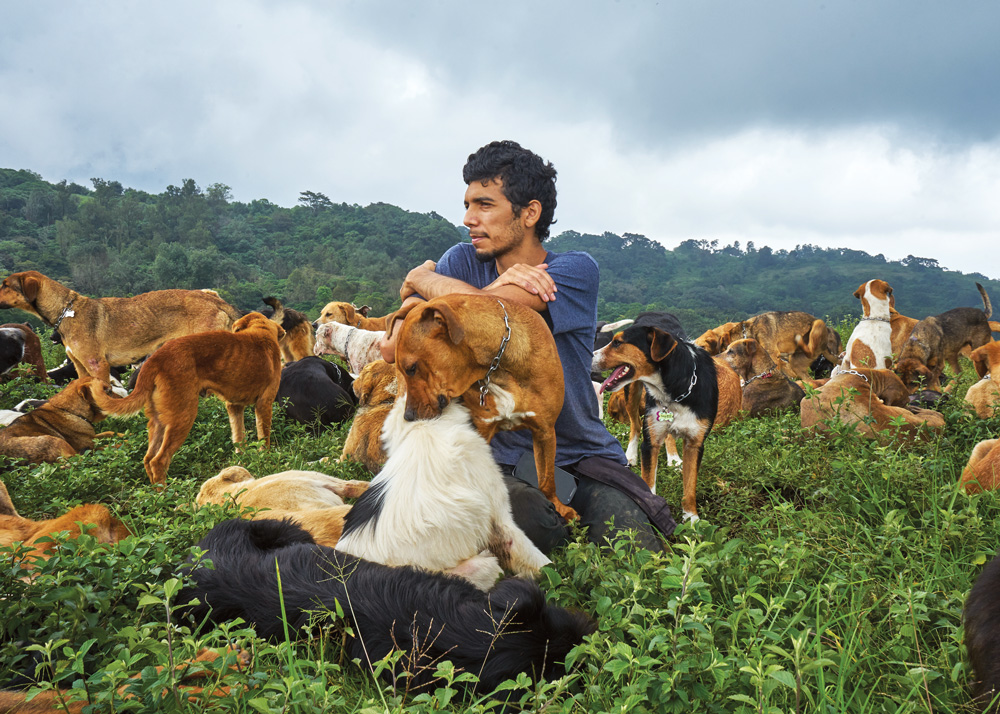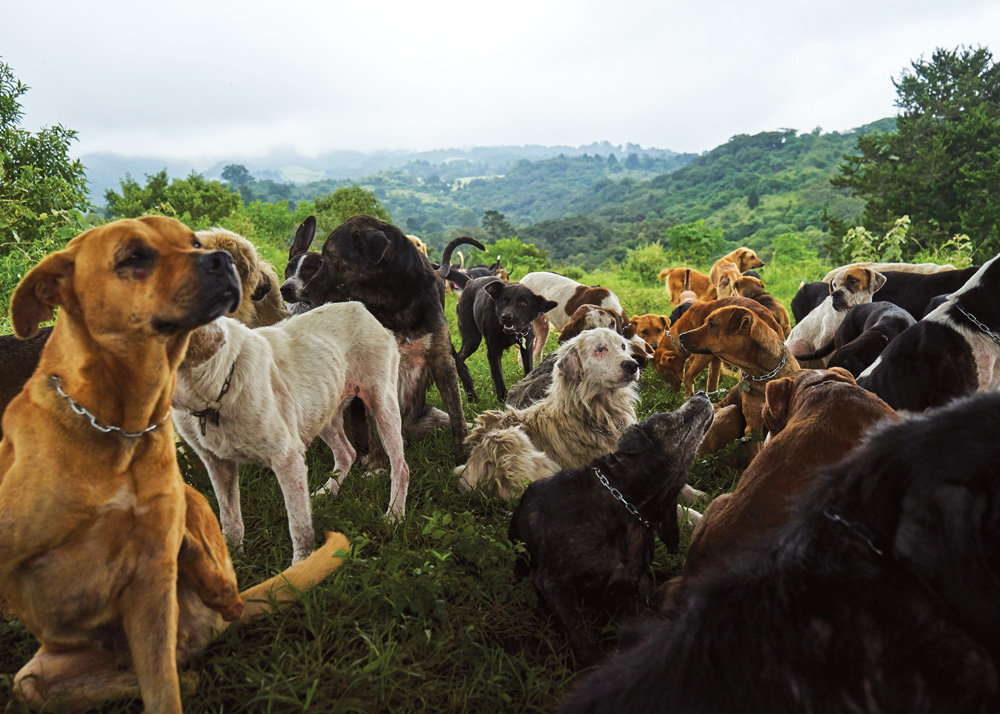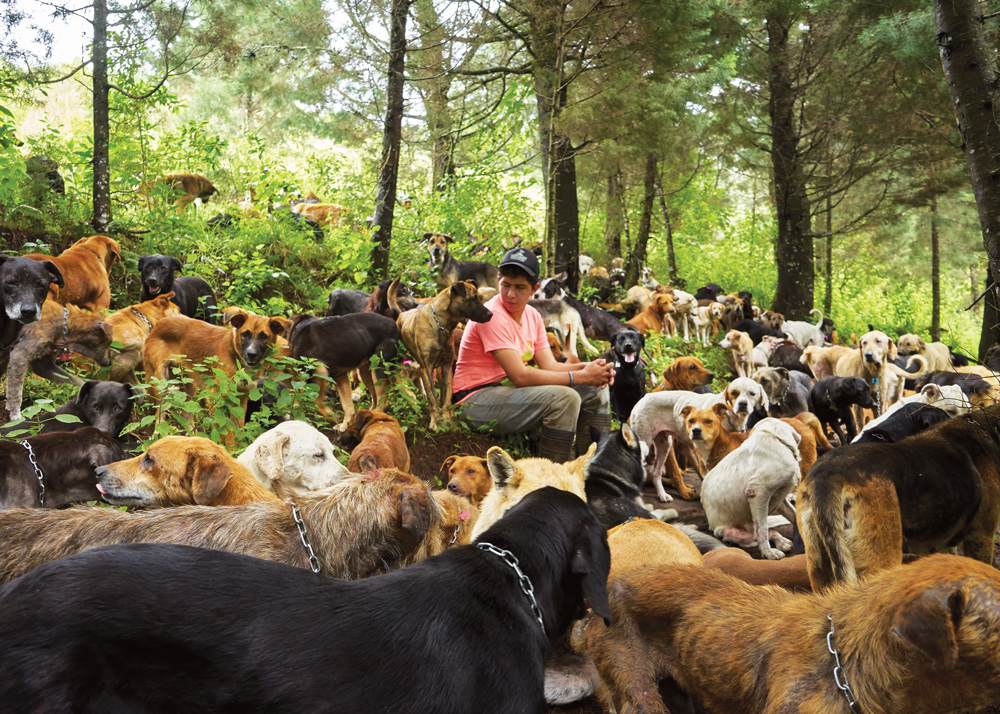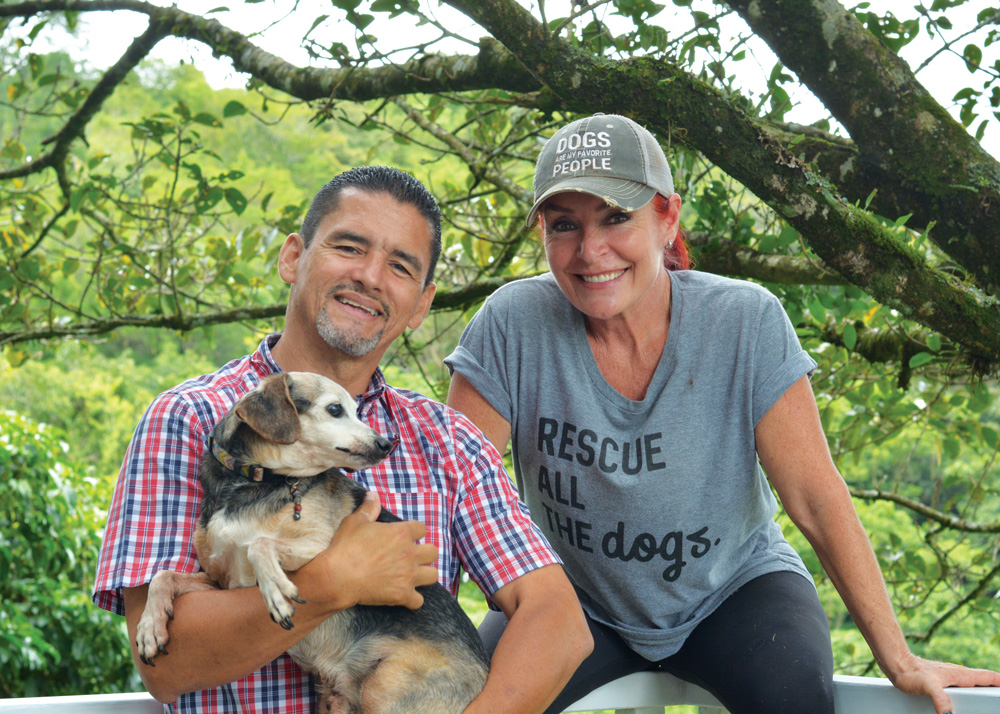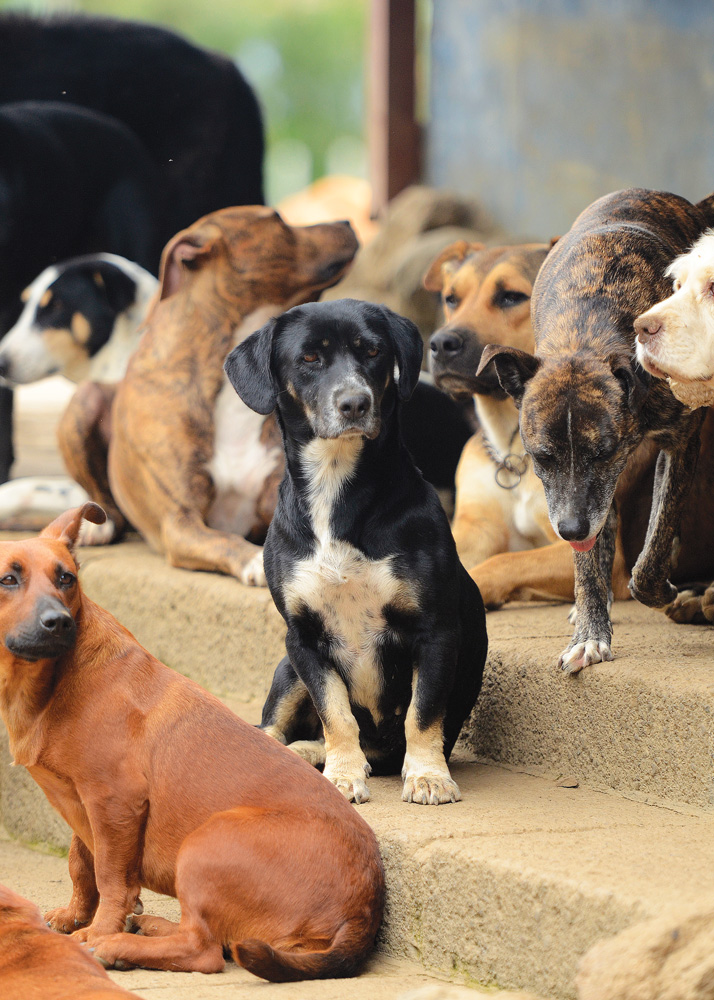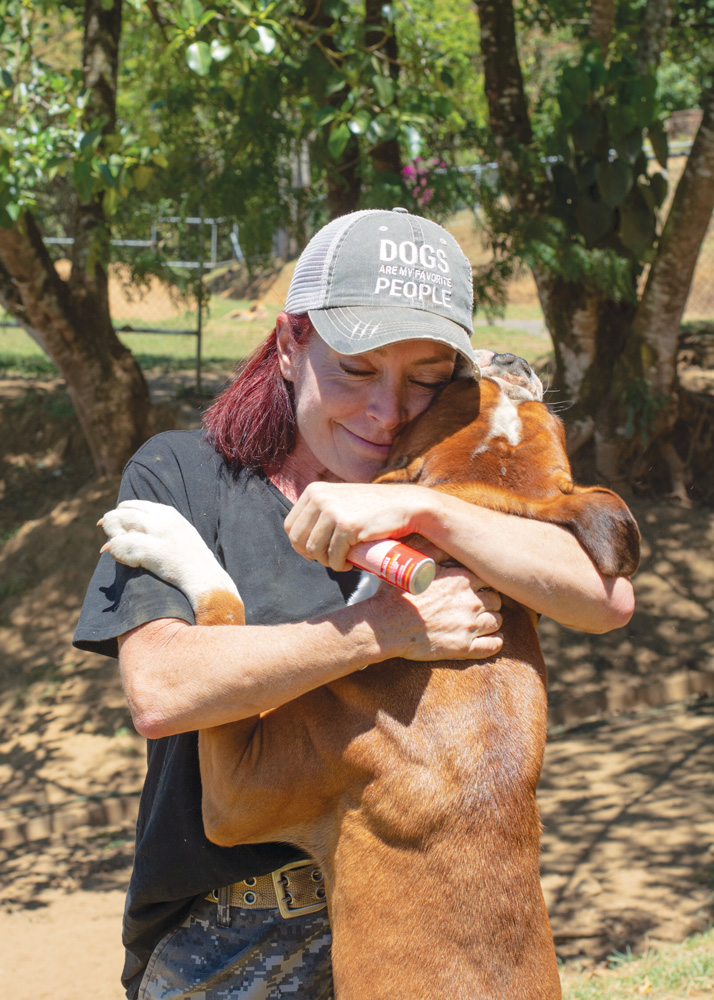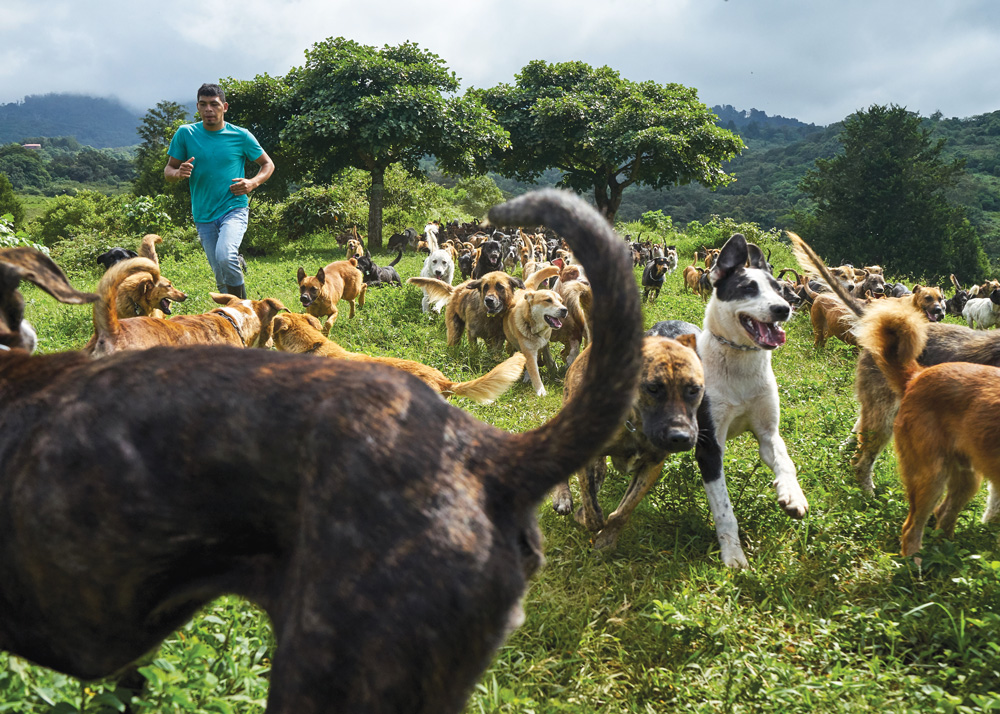

Land of the Strays
Paradise Found: a dog sanctuary in the mountains of Costa Rica is home to 2,000 free-roaming second-chance dogs
Volunteer José Rojas shares a quiet moment with his beloved dog Franco, who suffers from narcolepsy, as rain clouds begin to roll in during the late morning. Photo by Dan Giannopoulos
Deep in the fertile mountains near Heredia in Costa Rica, about an hour outside of San José, lies a 350-acre farm and sanctuary known as Territorio de Zaguates. Frequent rainfall feeds the lush green rolling hills and crystal-clear streams. The landowners allow for the natural trees and landscape to grow in, a wild contrast to the many nearby farms that clear-cut for cattle ranching.
Animals do run through the fields of this farm, but they are not of the livestock variety—they are dogs. Over 2,000 of them.
Owner Lya Battle inherited the farm from her father—it was originally owned by her grandfather, who selected his property based on its picturesque view. She simply did not know what to do with it before opening up the Territorio de Zaguates dog sanctuary and shelter about a decade ago. Today, she runs the operation along with her husband, Alvaro Saumet, and five full-time caretakers looking after more than 2,000 dogs. “Imagine this,” Lya says, setting the scene over the phone from Costa Rica. “Each day, we open the dog enclosures and let the dogs roam free. We take them for a four-kilometre walk up and down pastures, they run through rivers, roll in the grass, chase birds… It is pretty similar to paradise. Especially because it is full of dogs.”
The dogs rest before making their way back down to the main farm area for feeding time. Photo by Dan Giannopoulos
Despite being a lifelong animal lover, Lya spent her early years unaware of just how bad the stray situation was in San José. That changed when she moved to a suburban neighbourhood with her husband almost 15 years ago, and she encountered many more strays—as well as one particularly beautiful dog with an eye problem. “Imagine a handsome Husky, but with two shades of yellow, and probably mixed with a Shar Pei because he had these little triangular-shaped ears,” she recalls. Lya was smitten; she took the stray to a vet to get his eyes fixed, expecting to find an owner for him after the fact. “That was the first time I thought of holding on to a dog until someone wanted him, which ended up being his entire life, because nobody ever did.”
Naming the dog Oso (Bear in Spanish), the golden-hued canine marked the beginning of a life’s mission that has grown far beyond what Lya ever anticipated. “I realized there are a lot of dogs out there who don’t have a home, and there simply wasn’t an option for them,” she says. “They are either risking their lives on the street, or they are waiting for their due date [to be euthanized] in a shelter. That’s it. And that became a haunting feeling for me.”
José Soto, a local caretaker, sits with the dogs during a rest break on their daily walk. Photo by Dan Giannopoulos
One by one, she added to her count of rescues, but when the tally reached over 100, moving them to the farm was the natural next step despite some naysayers who didn’t believe large packs of dogs could co-exist in harmony. Quite the opposite, Lya’s rag-tag clan of strays was happy to live as a herd, and she noticed behaviourally how the new dogs were taught by the old guard. (It also helps that all the dogs are spayed and neutered.)
At Territorio de Zaguates, each dog is a member of the greater family, and each dog is given its own name. A large part of Lya’s operation is adopting them out to welcoming homes, not only in Central America, but to the United States and Canada, too. Prospective families are carefully screened in advance, but even then, the dogs can be returned to the farm if there are any issues. “I always tell people, ‘There is no expiry date on this adoption.’ We won’t even ask questions,” says Lya. “If you can’t have them anymore, for whatever reason, bring them back.” While it is sad to see a dog returned, there is deep reassurance for Lya knowing that they are safe.
About 15 years ago, adopting dogs was virtually unheard of in Costa Rica; Lya explains how there is still so much education that needs to take place—not only about adoption, but caring properly for pets in general “People always want puppies, too, so we have to educate them on adopting adults,” she adds. These days, new dogs generally join the sanctuary as a result of tips that they receive about abandoned dogs. While adoption numbers move faster than they used to, they could always be quicker.
Territorio de Zaguates dog sanctuary founders Lya Battle and husband Alvaro Saumet. Photo by Paola Bonilla Fong (IG: ppunto.photo)
Running the operation not only takes a lot of heart, but a lot of funding. Lya and her husband do not make a profit from the shelter and work separate jobs in order to keep it afloat. (Four days a week, she works as an educational consultant; Friday is dedicated to running around on the farm.) Donations help, too. The sanctuary has a robust online presence and donation platform and the local vets who allow the organization to keep running tabs. The weekly dog food bill—they go through 20 sacks of kibbles daily, each weighing 30 kilograms—is also incredibly high. But for Lya, it is all worth it: “I never really intended to do this. I just realized that the existing reality was not something I was comfortable with, and I tried something different because it was the least I could do. And I’m still trying.”
“The dogs roam free… they run through rivers, roll in the grass, chase birds…It is pretty similar to paradise. Especially because it is full of dogs.”
Trying is an apt descriptor for other reasons, too. Of the daily challenges Lya and Alvaro face, the biggest of them all is working through the hoops of government regulation, at all levels. “Our government is not going to help a dog on the street. We don’t even have municipal pounds,” Battle says. “But then the government wants us to build our shelter their way? Keeping all the dogs in cages, for example? No. This is my property. So, they’ve tried to come up with as many challenges and problems that they can put in our way.” Although she says they have been demonized because they are doing something different, Lya, true to her last name, keeps fighting. For her, it is better than the alternative. “It has almost become like a tug of war for us and the government, which we usually end up winning every time because, really, how can you deny that what we are doing is working? It’s working.” The proof, for her, is in the happiness of the dogs, living in the verdant hills with kind caretakers and enough food, free from stress and trauma.
Photo by Diana Méndez Arias (IG: dimearias). Founder Lya Battle hugs one of the sanctuary dogs. Photo by Paola Bonilla Fong (IG: ppunto.photo)
“I sometimes tell people ‘I have a farm full of walking deads’—that is, dogs that would have been euthanized but are there because they had a chance.” Even though some of the sanctuary’s inhabitants are on their last legs—are elderly, or have cancer, for example—they will at least will leave this earth from a loving environment. One dog, named Abuelo (which means Grandfather in Spanish) came at the age of 12 after his owner passed away. Not only did he live to be age 21 at the shelter, but after a video of his birthday party was shared on the shelter’s social media account, he got adopted. Still alive and living with his new family, he is now almost 24 years old. Today, Abuelo lives like a prince in a large house with multiple doggy beds and a pool he likes to lay beside. “These are the stories that keep me going,” says Lya. “Nothing is more fulfilling than that, nothing can take up more of my heart than that.”
With visitors to the sanctuary suspended first due to construction, then due to Covid-19, the educational group walks with visitors have been put on hold, although there are hopes to start them up again in the new year. “That was our way of teaching 300 people in a weekend about how to care for dogs,” she says, “and getting a whole bunch of dogs adopted in the process.”
José Rojas, a volunteer from Costa Rica, and Darlin, a senior caretaker from Nicaragua, supervise the dogs during their daily walk. Photo by Dan Giannopoulos
Still, Lya remains hopeful, and the land of the strays, as many call the farm, remains vibrant. “I think only Costa Ricans call their mutts zaguates,” says Lya referencing their name, explaining that the word is taken from the Bri-bri language of Costa Rica’s Indigenous people from Talamanca. “When I gave our farm its name, people questioned it, but you know what I said to them? ‘There is absolutely no shame in being a dog who doesn’t have a breed. A zaguate is a survivor. A zaguate does not come from the prettiest dog made to mate with the other prettiest dog. No, it is a survivor with a survivor. If there is anything like a superhero, and a warrior, it is a zaguate. It is a dog that made it, against all odds.”
The dogs run excitedly across a hilltop just behind the main farm under the watch of Alex, a caretaker at the farm. Photo by Dan Giannopoulos
Join the newsletter and never miss out on dog content again!
"*" indicates required fields
By clicking the arrow, you agree to our web Terms of Use and Privacy & Cookie Policy. Easy unsubscribe links are provided in every email.
